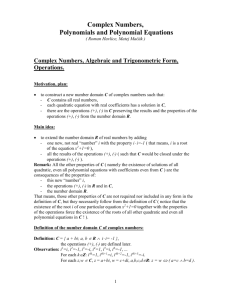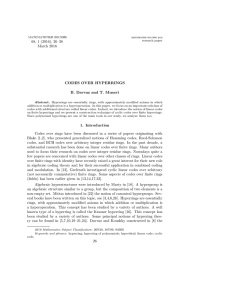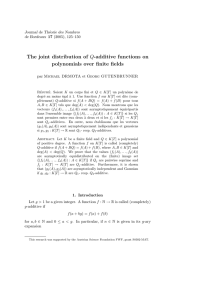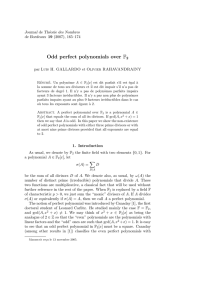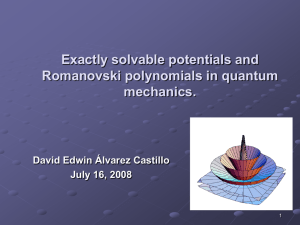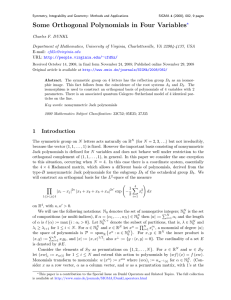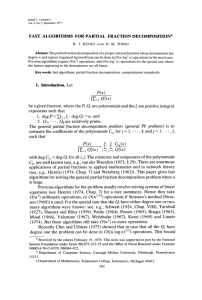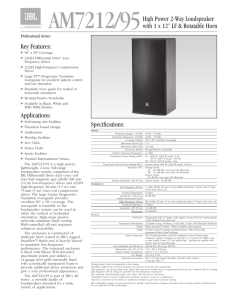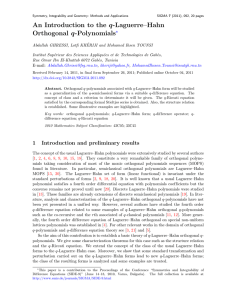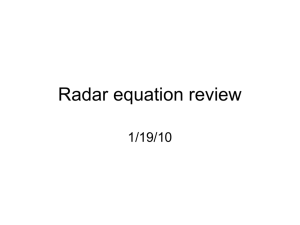60 (2008), 3–8 THE RESULTANT OF NON-COMMUTATIVE POLYNOMIALS Aleksandra Lj. Eri´ c
advertisement
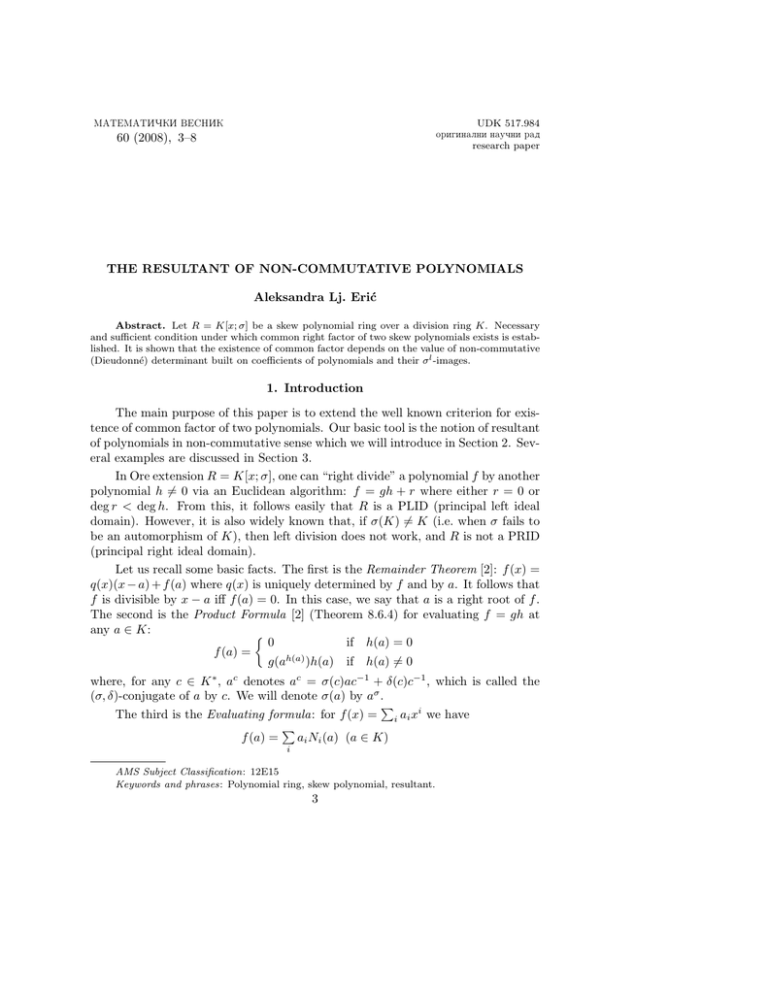
MATEMATIQKI VESNIK
UDK 517.984
originalni nauqni rad
research paper
60 (2008), 3–8
THE RESULTANT OF NON-COMMUTATIVE POLYNOMIALS
Aleksandra Lj. Erić
Abstract. Let R = K[x; σ] be a skew polynomial ring over a division ring K. Necessary
and sufficient condition under which common right factor of two skew polynomials exists is established. It is shown that the existence of common factor depends on the value of non-commutative
(Dieudonné) determinant built on coefficients of polynomials and their σ l -images.
1. Introduction
The main purpose of this paper is to extend the well known criterion for existence of common factor of two polynomials. Our basic tool is the notion of resultant
of polynomials in non-commutative sense which we will introduce in Section 2. Several examples are discussed in Section 3.
In Ore extension R = K[x; σ], one can “right divide” a polynomial f by another
polynomial h 6= 0 via an Euclidean algorithm: f = gh + r where either r = 0 or
deg r < deg h. From this, it follows easily that R is a PLID (principal left ideal
domain). However, it is also widely known that, if σ(K) 6= K (i.e. when σ fails to
be an automorphism of K), then left division does not work, and R is not a PRID
(principal right ideal domain).
Let us recall some basic facts. The first is the Remainder Theorem [2]: f (x) =
q(x)(x − a) + f (a) where q(x) is uniquely determined by f and by a. It follows that
f is divisible by x − a iff f (a) = 0. In this case, we say that a is a right root of f .
The second is the Product Formula [2] (Theorem 8.6.4) for evaluating f = gh at
any a ∈ K:
½
0
if h(a) = 0
f (a) =
h(a)
g(a
)h(a) if h(a) 6= 0
where, for any c ∈ K ∗ , ac denotes ac = σ(c)ac−1 + δ(c)c−1 , which is called the
(σ, δ)-conjugate of a by c. We will denote σ(a) by aσ .
P
The third is the Evaluating formula: for f (x) = i ai xi we have
P
f (a) =
ai Ni (a) (a ∈ K)
i
AMS Subject Classification: 12E15
Keywords and phrases: Polynomial ring, skew polynomial, resultant.
3
4
A. Lj. Erić
where N0 (a) = 1 and inductively
Nn+1 (a) = σ(Nn (a))a + δ(Nn (a)) (n ∈ N0 ).
In the case when δ = 0, Nn (a) = σ n−1 (a)σ n−2 (a) · · · σ(a)a.
2. The resultant of non-commutative polynomials
First let us recall the well known criterion for existence of a common factor of
two ordinary polynomials in the ring F [x], where F is a field:
Let f, g ∈ F [x], F be a field and deg f = m, deg g = n. Polynomials f, g have
a common right factor iff there exists polynomials c, d ∈ F [x] such that:
cf = dg
where deg c < deg g and deg d < deg f .
In this section, we are going to extend this criterion to the skew polynomials
with δ = 0. Although the ring R := K[x; σ, δ] is non-commutative, it is still a UFD
(unique factorization domain) in the sense of [3] (page 28). Let us mention some
more advanced facts about the skew polynomials.
Proposition 2.1. ([6], Theorem 2.2) (1) Let f ∈ K[x, σ]. Then R/Rf is a
left K-vector space and dim R/Rf = deg f .
(2) Let f, g ∈ K[x, σ]. Then Rf /Rg is a left K-vector space and dim Rf /Rg =
deg g − deg f .
Proposition 2.2. ([6], Theorem 2.2) Let E1 and E2 be submoduls of an
R-modul E, when R is a ring. Then the sequence
0 −→ E1 ∩ E2 −→ E1 + E2 −→ (E1 + E2 )/E1 ⊕ (E1 + E2 )/E2 −→ 0
is exact.
Proposition 2.3. ([6], Theorem 2.2) Let f, g ∈ R = K[x; σ] and deg f > 0,
deg g > 0. If k, h ∈ R so that Rf ∩ Rg = Rh and Rf + Rg = Rh, then
deg f + deg g = deg h + deg k.
Here is the main result of this section.
Theorem 2.4. Let f, g ∈ R = K[x; σ] and deg f = n, deg g = m. Polynomials
f and g have a common right (nonunit) factor if and only if there exist polynomials
c, d ∈ R such that cf = dg and deg c < m and deg d < n.
Proof. Since R is a PLID, we have Rf ∩ Rg = Rh, and Rf + Rg = Rk. From
h ∈ Rf , it follows that h = cf for some c ∈ R, and similarly h ∈ Rg implies that
h = dg for some d ∈ R.
The resultant of non-commutative polynomials
5
Assume that polynomials f and g have common right (nonunit) factor k1 .
Then k1 is a right factor of k and deg k ≥ deg k1 > 0. According to the Proposition
2.3., we have
deg k + deg h = deg f + deg g.
(1)
It follows that deg h < deg f + deg g which means that deg c < deg g, and deg d <
deg f .
Conversely, suppose that there exist c, d ∈ R, deg c < m, deg d < n such that
cf = dg = h1 . Then h1 ∈ Rh, so deg h ≤ deg h1 < m + n ≤ deg f + deg g. Thus
it follows from equation (1) that deg k > 0. It means that k is nonunit and also a
right factor of the polynomials f, g (according to the fact Rf + Rg = Rk).
Now, we are going to introduce a notion of resultant in non-commutative setting. If
m
n
P
P
f=
ai x i , g =
bi xi
i=0
i=0
and
c=
n−1
P
i=0
ci xi ,
d=
m−1
P
i=0
di x i
are the polynomials from Theorem 2.4., then
cf =
k
PP
k i=0
So the equality cf = dg means
i
σ
ci ak−i
xk , dg =
k
P
i=0
k
P
i
ci aσk−i =
i=0
k
PP
k i=0
i
di bσk−i xk .
i
di bσk−i for all 0 ≤ k < m + n.
For example, for m = n = 2 we get the system of linear equations with
unknowns c0 , c1 , −d0 , −d1 :
c0 a0
− d0 b0
c0 a1 + c1 aσ0
c0 a2 + c1 aσ1
c1 aσ2
=0
− d0 b1 −
− d0 b2 −
−
d1 bσ0
d1 bσ1
d1 bσ2
=0
=0
=0
The determinant of this system is
¯
¯ a0
¯
¯ 0
¯
¯ b0
¯
0
a1
aσ0
b1
bσ0
a2
aσ1
b2
bσ1
¯
0 ¯
σ¯
a2 ¯
¯.
0 ¯
σ ¯
b2
In general, we get a system of m + n linear equations with m + n unknowns
c0 , . . . , cm−1 , −d0 , . . . , −dn−1 with coefficients in division ring K ([4]). The deter-
6
A. Lj. Erić
minant of the system is
¯
¯ a0 a1
¯
¯ 0 aσ0
¯
¯ ..
..
¯ .
.
¯
¯ 0
0
¯
¯ b0 b1
¯
¯ 0 bσ0
¯
¯ .
..
¯ ..
.
¯
¯ 0
0
a2
aσ1
..
.
0
b2
bσ1
..
.
0
...
...
..
.
...
...
...
..
.
...
an
aσn−1
..
.
n−1
aσ0
bm
bσm−1
..
.
m−1
b0σ
0
aσn
..
.
n−1
a1σ
0
bσm
..
.
m−1
bσ1
...
...
..
.
...
...
...
..
.
...
¯
¯
¯
¯
¯
¯
¯
n−1 ¯
¯
aσn
¯.
0 ¯¯
0 ¯¯
¯
¯
¯
m−1
¯
σ
b
0
0
m
This is an (m + n) determinant over division ring where m and n are degrees of
polynomials f and g. It is also called the Dieudonné determinant ([5]) and it takes
values in the factor group K ∗ /[K ∗ , K ∗ ] ∪ {0} where [K ∗ , K ∗ ] is the commutator of
the multiplicative group K ∗ = K \ {0}. We will denote this determinant by R(f, g),
and we will call it the resultant of polynomials f and g.
If the system has a nontrivial solution, determinant must be zero. Conversely, if determinant is zero, then system has a nontrivial solution. So, there exist
polynomials c, d ∈ R such that cf = dg and deg c < deg g, deg d < deg f .
Theorem 2.5. Polynomials f , g from R = K[x, σ] have a common (nonunit)
right factor iff R(f, g) = 0.
Corollary 1. Let f, g ∈ R = K[x; σ],
Then
¯
¯ a0
a1
a2
¯
¯ −d
1
0
¯
σ
1
R(f, g) = ¯¯ 0 −d
..
..
¯ ...
.
.
¯
¯ 0
0
0
f (x) = an xn + · · · + a0 , g(x) = x − d.
¯
...
an−1
an ¯
¯
...
0
0 ¯
¯
...
0
0 ¯.
..
..
.. ¯¯
.
.
. ¯
n−1
. . . −dσ
1 ¯
We switch the first and the last row and then move columns cyclically. We get
¯
¯
n−1
¯ 1 −dσ
0
...
0
0 ¯
¯
¯
n−2
¯ 0
1
−dσ
...
0
0 ¯
¯
¯
n−3
0
1
. . . −dσ
... ¯.
R(f, g) = ¯¯ 0
..
..
..
.. ¯¯
..
¯ ..
.
.
.
.
. ¯
¯ .
¯
¯
an
an−1
an−2
...
a1
a0
We continue the procedure until we get a determinant which differs from unit in
the last place ((n + 1, n + 1) entry). The last place will be
a0 + . . . + an−1 dσ
n−2
· · · dσ d + an dσ
n−1
· · · dσ d
and that is f (d). So R(f, g) = 0 iff f (d) = 0. This means that f is divisible by
x − d iff f (d) = 0.
7
The resultant of non-commutative polynomials
Example 1. Let R = D[x] where D is the ring of real quaternions. First, we
consider a pair of polynomials
f (x) = x2 − (i + j)x − ij = (x − j)(x − i),
g(x) = x2 − jx + (1 − ij) = (x + i − j)(x − i).
¯
¯
−(i + j)
1
0¯
¯ −ij
¯
¯
−ij
−(i + j) 1 ¯
¯ 0
R(f, g) = ¯
¯.
−j
1
0¯
¯ 1 − ij
¯
¯
0
1 − ij
−j
1
This is a Dieudonné determinant. We get a determinant which differs from unit
in the last place by left multiplying its rows. The last place is R(f, g) = 0, so the
polynomials f, g have a common right factor.
Next, let us consider
f (x) = (x − j)2 = x2 − 2jx − 1,
g(x) = (x + i − j)(x − i) = x2 − jx + 1 − ij.
We get a determinant which differs from unit in the last place by left multiplying
its rows. The last place is R(f, g) = −2 + 4i + [D∗ , D∗ ] 6= 0, so the polynomials
f, g have no common right factor.
Example 2. Let R = K[x], where K is the field of fractions ([2]) of the skew
polynomial ring C[t;¯ ], i.e. K = C(t;¯ ). For the pair of polynomials
f (x) = x2 + t−1 ,
g(x) = (t − 1)−1 x3 + (t2 − 1)(t − i)x2 + (t2 − t)−1 x + (t3 − t)−1 (t − i),
R(f, g) is
¯
t−1
0
1
0
¯
¯
0
t−1
0
1
¯
¯
0
0
t−1
0
¯
¯ 3
−1
2
−1
2
(t − t)
(t − 1)(t − i)
(t − 1)−1
¯ (t − t) (t − i)
¯
0
(t3 − t)−1 (t − i)
(t2 − t)−1
(t2 − 1)(t − i)
¯
0
¯
¯
0
¯
¯
1
¯.
¯
0
¯
¯
(t − 1)−1
This is a Dieudonné determinant and R(f, g) = 0, so the polynomials f and g have
a common right factor. But polynomial f is irreducible, so f is a factor of the
polynomial g. Really,
g(x) = ((t − 1)−1 x + (t2 − 1)(t + i))(x2 + t−1 ).
Note that (t2 − 1)−1 (t + i)t−1 = (t3 − t)−1 (t − i).
Let R = K[x; 1; δ] where δ is a σ-derivation. R is a PLID and it has the
algorithm of dividing. Thus we can apply the same argument as before.
For f, g ∈ R, where deg f = deg g = 2, R(f, g) is
¯
¯
a1
a2
0 ¯
¯ a0
¯ δ
¯
δ
δ
¯ a0 a1 + a0 a2 + a1 a2 ¯
¯
¯.
b1
b2
0 ¯
¯ b0
¯ δ
¯
b0 bδ1 + b0 bδ2 + b1 b2
8
A. Lj. Erić
Pn
Pm
In general, if f (x) = 0 ai xi and g(x) = 0 bi xi , than R(f, g) is a determinant
of dimension (m + n).
The first row is (a0 , . . . ,an ,0,...0), and the (i + 1)-th row is Ai+1,j (1 < j ≤
m − 1), where
¶
µ
j−1
P
i
i−k
Ai+1,j =
aδj−1−k
i−k
0
¡i¢
where −l = 0 for l > 0 and ai = 0 for i > n and the m + 1-th row is (b0 , . . . ,bm ,0,
. . . ,0).
µ
¶
j−1
P
i
i−k
Ai+1+m,j =
bδj−1−k
i−k
0
¡i¢
where −l = 0 for l > 0 and bi = 0 for i > m and 0 < i ≤ m − 1.
Example 3. Let K = R(t), R = K[x; 1;0 ] where 0 is the standard derivation.
Then
xr(t) = r(t)x + r0 (t)
for r(t) ∈ R(t). For the polynomials
1
1
f (x) = (x − )(x − t) = x2 − (t + ) and g(t) = x(x − t) = x2 − tx − 1,
t
t
¯
¯
¯ 0
1
0 ¯¯
−(t
+ 1t )
¯
¯ 0 −(1 − 12 ) −(t + 1 ) 1 ¯
¯ = 0,
t
t
R(f, g) = ¯¯
−t
1
0 ¯¯
¯ −1
¯ 0
−2
−t
1¯
so polynomials f, g have a common factor.
On the other hand, for
f (x) = (x − t)x = x2 − tx,
g(x) = x(x − t) = x2 − tx − 1,
R(f, g) = −1, so the polynomials have no common factors.
REFERENCES
[1] O. Ore, Theory of non-commutative polynomials, Ann. Math. 34 (1933), 480–508.
[2] P. M. Cohn, Free Rings and Their Relations, 2nd Ed., London Math. Soc. Monograph No.
19, Academic Press, London, 1985.
[3] P. M. Cohn, Skew Fields. Theory of General Division Rings, Encyclopedia in Math., Vol. 57,
Cambridge Univ. Press, Cambridge, 1995.
[4] E. Artin, Geometric Algebra. Interscience Publishers Ltd., London, 1957.
[5] J. Dieudonné, Les déterminants sur un corps non commutatif, Bull. Soc. Math. France 71
(1943), 27–45.
[6] J. B. Castillon, These de doctorat d’etat sciences mathematiques a la faculte des science de
Montpellier, 1971.
(received 20.08.2006, in revised form 16.11.2007)
Faculty of Civil Engineering, University of Belgrade, Bulevar Kralja Aleksandra 73, 11000
Beograd, Serbia
E-mail: eric@grf.bg.ac.yu
